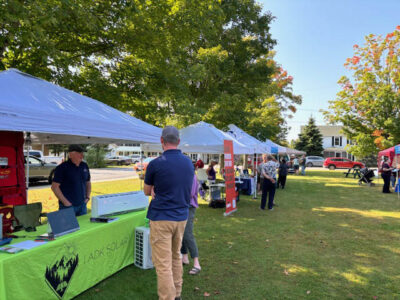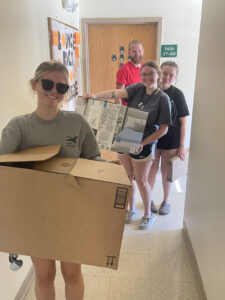State lawmakers hold road salt reduction roundtable
Umbrella of agencies and stakeholders meet in Albany
ALBANY — The chairs of three state Assembly committees, officials from the state agencies those lawmakers oversee, local government leaders and a group of experts and stakeholders convened on Aug. 21 for a roundtable discussion on road salt, and the need to reduce its use.
The assembly members included Transportation Committee Chair Bill Magnarelli, D-Syracuse, Environmental Conservation Chair Deborah Glick, D-Manhattan, and Health Chair Amy Paulin, D-Brooklyn, with staff from the state Department of Transportation, Thruway Authority, Department of Environmental Conservation and Department of Health present.
There were also representatives from county and municipal associations, the New York City Department of Environmental Protection, Cornell University and a number of environmental protection advocacy groups. These included the Lake George Association, the Adirondack Council, Riverkeeper and ADKAction.
The roundtable was organized by Magnarelli and was meant to renew the conversation around road salt application between those calling for its reduction, those with data on its impact and those ultimately in charge of its distribution.
“The idea was not to discuss whether we had a problem,” Magnarelli said. “Everyone around the table agreed there is a problem — and we have to do things to mitigate the problem.”
Though the adverse environmental and health effects of road salt contamination have been scientifically evidenced for decades, Magnarelli said getting the word out and educating people about that remains an obstacle. He said some of the roundtable participants noted that they had been told by some of their constituents that if they don’t have the salt crunching under their feet, they feel unsafe.
“And that’s just not true,” Magnarelli said. “If you see the salt and it’s crunching under your feet, you’ve got way too much salt on the road. Way too much. You don’t need anything like that. So, we’ve got to convince people.”
Part of that, Magnarelli said, involves showing that the salt doesn’t magically disappear, but rather leeches into groundwater, where it can render wells undrinkable, or surface water, where it can disrupt natural ecosystems.
“Everybody has to understand that rock salt is something that will contaminate our water system, so we need to ratchet that back,” he said. “And we need to ratchet it back to a point where we’re not endangering the public on the streets as well.”
Magnarelli said that while he is pushing for improvements from the state DOT — which has been a longtime call from conservation groups who said the agency is lagging behind Adirondack municipalities’ road salt reduction — he said that across the state, municipalities, individuals and private contractors are responsible for the bulk of the salt application. For the effort to be effective, he said everyone has to pitch in — and that the same principle that applies to state-maintained roads applies to driveways, parking lots and local roads.
“One thing that we have to remember here is although the DOT is responsible for the Adirondacks’ main roads and also around our New York City reservoirs in the Catskills, DOT is only responsible for 10 to 11% of our roads in New York state,” he said. “The rest are municipalities.”
In addition to education, Magnarelli said that adequate funding has to be in place for the DOT and municipalities to get equipment that allows for effective surface treatment with less salt. These include precision-angled salt spreaders, salt brine tanks and plows that are better shaped with the roadway’s downward slope from the median — which minimizes ice accrual, resulting in less salt needed to treat the surface.
Lake George Association Executive Director Brendan Wiltse said the organization was appreciative of the roundtable. He noted that, as far as he was aware, it was the first time stakeholders and the various state agencies were in the same room talking to each other since the Adirondack Road Salt Reduction Task Force report was released in 2023.
The report can be viewed in its entirety at tinyurl.com/mr48nv6e.
“That’s really what, in essence, what we are pushing for,” he said. “To make sure that the conversation around this continues and not only that those agencies are at the table, but relevant experts and constituent groups to express their insight and opinion, but also the concern that people have around what’s happening to the environment and people’s drinking water.”
DEC Division of Water Assistant Director Alexander Smith said the agency has been active in finding ways to mitigate salt use and improve water quality, while maintaining public safety.
“We continue to work with our partnering agencies and stakeholders to follow through on Task Force recommendations wherever feasible, especially those directly under DEC’s purview,” he said.
Smith pointed to three areas the DEC has focused on since the 2023 report was released. One of those was investing in infrastructure improvements, especially ensuring that there are effective barriers around salt storage piles. These prevent it from leaching at a stage where large quantities of salt are, by necessity, highly concentrated in one spot.
Smith said this funding was provided through the Water Quality Improvement Projects Grant Program.
“To date, more than $52 million to 204 projects have been awarded statewide for salt storage and road salt reduction practices,” he said. “In 2024 alone, $15 million was awarded to 39 different projects and an additional $15 million was made available again this year.”
Another DEC focus has been reviewing state water quality standards for chloride, a primary component of rock salt, to enhance water quality protections.
“Our review will determine how best to implement the Task Force’s recommendations to adopt new standards for chloride as part of Triennial Water Quality Standards Rule Making,” Smith said.
The other DEC area of focus was launching the “Don’t Be Salty” public outreach and education campaign. Smith said this is meant to raise awareness around the potential impacts of overusing road salt and provide information on ways municipalities and property owners can reduce their use of road salt while maintaining safety.
Wiltse called on the DOT to increase its transparency around salt application, adding that the LGA does not feel that nearly enough has been done to provide public information on salt application rates, adding that the Adirondack Road Salt Reduction Task Force report fleshes out meaningful data points that should be made publicly accessible.
“We have had to file Freedom of Information Law requests with DOT to get that data,” Wiltse said. “The taskforce report recommends making that data available for folks to have access to. … In some instances, it takes us many months to even a year to get that information back from DOT.”
He added that this is not only crucial for giving the public an idea of how much salt is being applied at any given time, but also to track reduction efforts by seeing how application rates may, or may not, be changing over time. It was something that Magnarelli agreed needed to improve. He said that it was discussed at the roundtable, and he plans to keep pressing the DOT to make the information available for the public.
“Either we do it voluntarily and openly and transparently, or we’ll have to make them give it on a yearly basis or semi-annual basis,” he said. “And I’m prepared to do that.”
DOT spokesperson Joe Morrissey called the roundtable a “highly productive discussion,” adding that the agency is constantly evaluating and reevaluating ways it can effectively — and safely — reduce road salt.
“We’ve had documented success in doing so across New York thanks to our dedicated staff and an innovative approach,” he wrote. “The Department has made a lot of progress over the past few years, and we look forward to continuing these discussions as we sustain that progress, to further protect the environment while maintaining a safe highway system.”
Morrissey noted that the DOT is expanding some of its road salt management initiatives for the 2025-26 winter season, citing an Aug. 20 statement from the department that noted 13 new stretches of roadway where liquid brine would be applied, which has been found to provide surface treatment at a lower effective application rate than traditional granular salt.
“Historically, the 7-year statewide average application rate for granular salt was 194 pounds per lane-mile,” the release states. “During the 2024-25 snow and ice season, the statewide average application rate for granular salt was reduced to 172 pounds per lane-mile. Specifically, the DLA (Direct Liquid Application) method employed during this period achieved an even lower rate of 120 pounds per lane-mile while safely maintaining the state highway system for the traveling public.”
–
Going forward
–
Wiltse said the effects of road salt stretch far beyond one group or agency, making it important that all of the affected groups talk and understand each other’s latest findings, operational updates or concerns.
“While it’s a public safety issue for DOT and they’re the ones applying it to the roads, we know very clearly, it’s very well understood, this is also an environmental and human health concern,” he said. “There are people who literally can’t drink the water out of their wells because of this. Those agencies don’t normally, as far as we’re aware, have any venue to have conversations about this issue.”
Previously, the LGA had pushed for Assembly Bill 4481, which was sponsored by Assemblyman Billy Jones, D-Chateaugay Lake, and saw its equivalent bill pass the state Senate. It sought to establish two groups — the New York Road Salt Reduction Council and the New York Road Salt Reduction Advisory Committee — that would be tasked with developing and overseeing the implementation of findings from the Adirondack task force statewide by Jan. 1, 2028.
The bill proposed 15 members on the council, including representatives from the DOT, DEC, DOH Thruway Authority, NYC DEP, local government associations, legislature appointees and the chairperson of the advisory committee. This, in turn, was proposed to include up to 25 members tasked with supplying the council with data and findings about the impacts of road salt on drinking water and road safety implications that come with potentially reducing salt usage.
The Assembly bill, however, failed to make it out of the transportation committee. Magnarelli opposed it on the grounds that it was superfluous — creating too slow of a timeline with too many involved parties to effectively address the issue, a stance he maintained at the roundtable.
“He expressed during the roundtable that he wants to see action faster than what the legislation would mandate, essentially,” Wiltse said. “Whether it is the legislation that we have proposed and advocated for in the past, or some other means, fundamentally, what we feel needs to happen in order to make progress on this issue is there needs to be a consistent venue of discussion and collaboration.”
Magnarelli was encouraged to see uniform agreement at the roundtable that salt contamination was a problem, and said he would be continuing to advance the issue and its urgency ahead of the upcoming winter season.
“We have to make sure that people are educated and also hopefully give them the wherewithal to start this process of weaning us off of it,” he said. “My next step is basically to make sure that people follow up on what we’re talking about. I’ll be talking to the DOT (today) … and that will be one of the things I talk to them about.”


